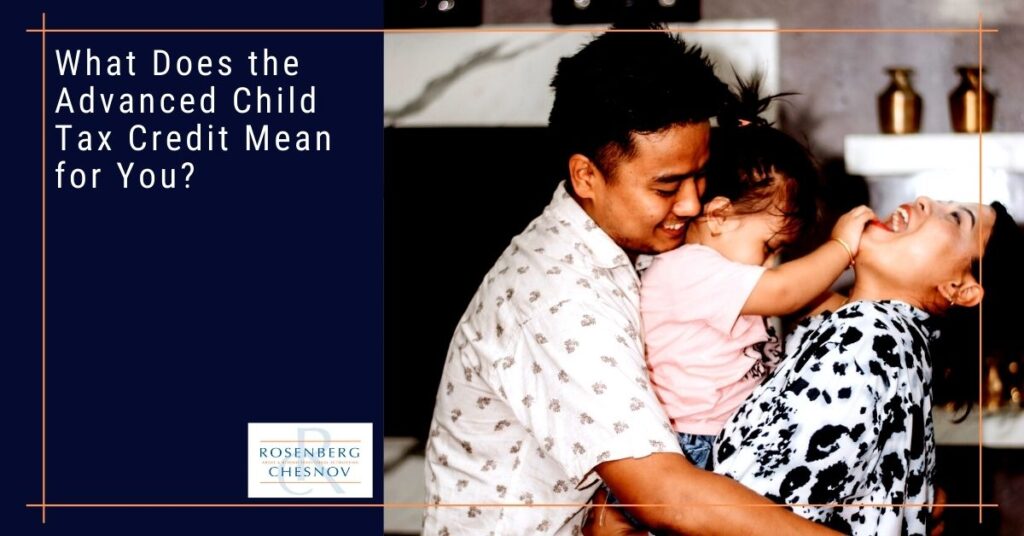How the Advance Child Tax Credit works
The Child Tax Credit has been available in some form since 1997, but as part of the American Rescue Plan, an expansion of this credit aims to get money to parents sooner.
Congress increased the total credit amount from $2,000 to $3,000 per child over six and $3,600 per child under six. They also increased the age limit from 16 to 17.
Over the next six months, the IRS will disburse 50 percent of the estimated amount claimable on 2021 tax returns in the form of direct advance payments. Some will even be as high as $300 per child per month.
To qualify, you must have:
- Filed a 2019 or 2020 tax return and claimed a Child Tax Credit in your return or gave the IRS your information in 2020 to receive the economic impact payment.
- Owned a main home in the United States for more than half the year (the 50 states and the District of Columbia), or filed a joint return with a spouse who has a main home in the U.S. for more than half the year.
- Have a qualifying child who is under age 18 at the end of 2021 and who has a valid Social Security number, and
- Made less than certain income limits.
Will you automatically get the child tax credit?
To get your payment, you most likely won’t need to do anything. If you filed tax returns in 2019 or 2020 or signed up to receive a stimulus check, the IRS will automatically enroll you. The IRS will pay out half of your credit amount with no additional action required from you between now and December (You’ll need to claim the other half on your 2021 tax returns).
If you have not filed your 2019 or 2020 tax returns, you will have to take action to receive your payment. With the IRS’s online Non-Filer tool, you can electronically file a simplified tax return and register for your Child Tax Credit.
The fastest way to get your payment is by direct deposit. If you don’t want to use direct deposit, you can choose to receive a check in the mail, which will arrive around the same time.
How much will you get each month?
The size of your family’s credit depends on the number and age of your children and your household income. Families earning up to $150,000 (or $112,500 for single parents), which is most working families, will receive the full credit.
If your income is higher than this, you may still be eligible for a reduced credit. For every $1,000 that exceeds the threshold, your tax credit decreases by $50 until the amount reaches $2,000.
Currently, monthly payments stop after six months, but the White House and some members of Congress have expressed hopes to extend the program into the future with further legislation.
Do you have to pay back the Child Tax Credit?
It’s important to understand that this credit is not the same thing as a stimulus payment.
Stimulus checks, like those sent during the COVID-19 pandemic, are one-time cash payments. But the Advance Child Tax Credit is just that—an advance. It is a payment on credit that already exists.
The IRS estimates the total amount of your advance payments based on the information you’ve already provided. But the estimate may prove to be incorrect. This can happen due to changes in your income, marital status, or the number of qualifying children.
If the total advance payment is greater than the amount you would properly claim, you may have to repay the excess on your 2021 tax return.
However, you may not have to repay some or all of any excess payment in some instances.
Qualifying for repayment protection.
You may qualify for repayment protection if a change in the number of qualifying children causes this excess and your income is below a specified amount for your filing status. In that case, you won’t need to repay any excess amount.
You may qualify for the maximum amount of protection, $2,000 if your modified adjusted gross income (AGI) is at or below the following amounts based on the filing status for your 2021 income tax return.
- $60,000 if you are married and filing a joint return or filing as a qualifying widow(er).
- $50,000 if you are filing as head of household.
- $40,000 if you are a single filer or married and filing a separate return. As your income increases over the above threshold amount, the amount of the repayment protection decreases. You will not qualify for any repayment protection once your modified AGI reaches the following levels.
- $120,000 if you are married and filing a joint return or filing as a qualifying widow(er).
- $100,000 if you are filing as head of household.
- $80,000 if you are a single filer or married and filing a separate return.
To ensure your information is up-to-date, use the IRS Child Tax Credit Update Portal (CTC UP). This portal will help improve the accuracy of your estimate and minimize any potential excess payment.
Can you get the Child Tax Credit in one lump sum?
Advance payments can bring immediate relief to families in financial distress. But you might prefer to wait and take your credit in one lump sum next year. If you’ve already budgeted the money for a big expense, you expect your tax situation to change this year, or you don’t want to risk overpayment, opting out of the advance may be best for you.
Although it’s too late for July, there is still time to unenroll from future payments. You can opt-out of the following month’s payment via CTC UP before the deadline (see below).
Child Tax Credit payment unenrollment dates
| Payment month | Unenrollment deadline | Payment date |
| July | June 28 | July 15 |
| August | August 2 | August 13 |
| September | August 30 | September 15 |
| October | October 4 | October 15 |
| November | November 1 | November 15 |
| December | November 29 | December 15 |
As of now, you cannot re-enroll once you unenroll. However, this is set to change later in the summer. Additionally, if you are married and file jointly, both you and your spouse will have to unenroll individually.
Remember, opting out of monthly advance payments does not mean you won’t receive your full Child Tax Credit. It simply means you are delaying your payment so that you can receive a lump sum later on.
Would you like some help?
If you are a client and would like to book a consultation, call us at +1 (212) 382-3939 or contact us here to set up a time.
If you aren’t a client, why not? We can take care of your accounting, bookkeeping, tax, and CFO needs so that you don’t have to worry about any of them. Interested? Contact us here to set up a no-obligation consultation.
Stay Informed
Interested in receiving updates in your mailbox? Check out our newsletter, full of information you can use. It comes out once every two weeks and you can register for it below.





